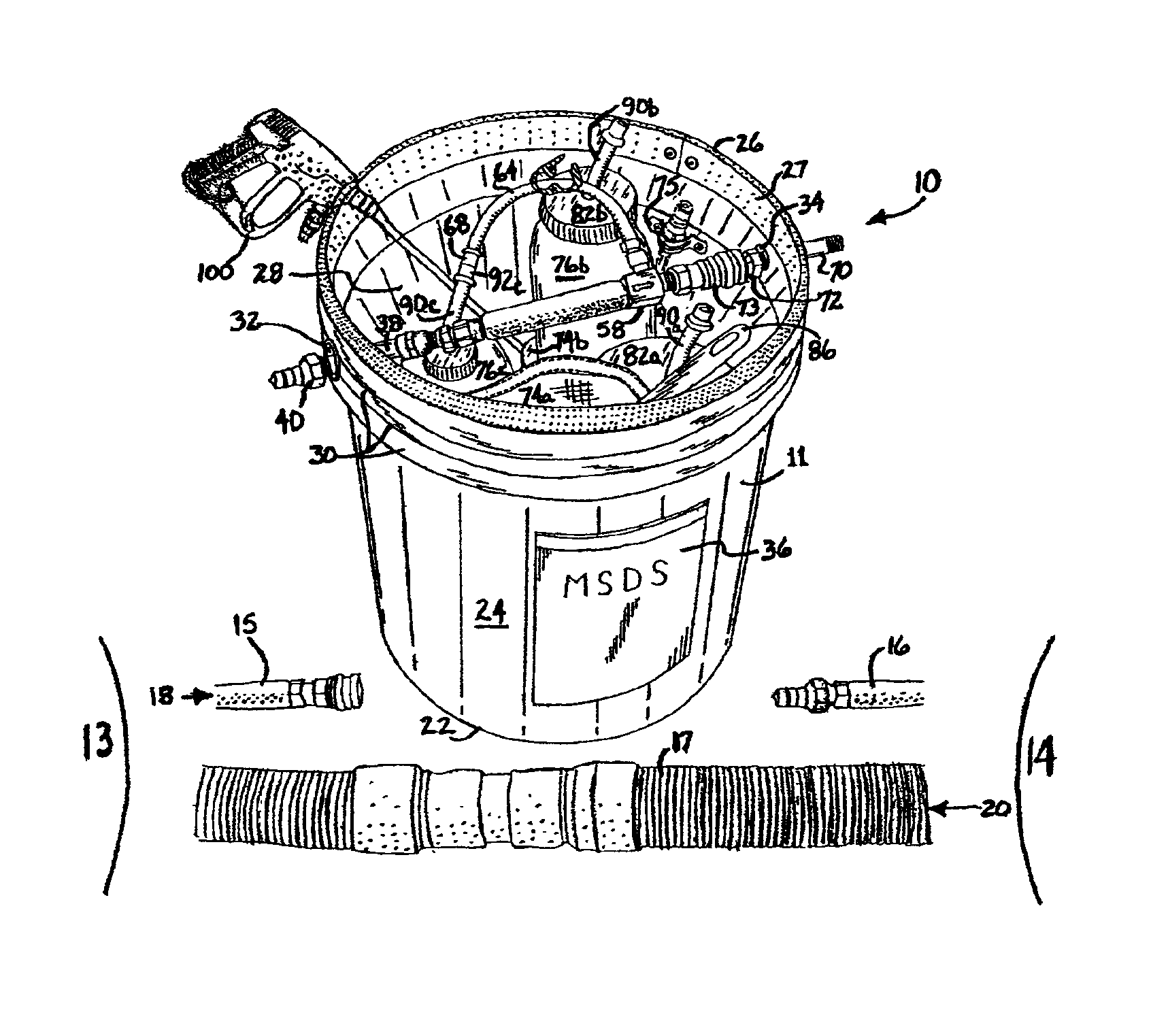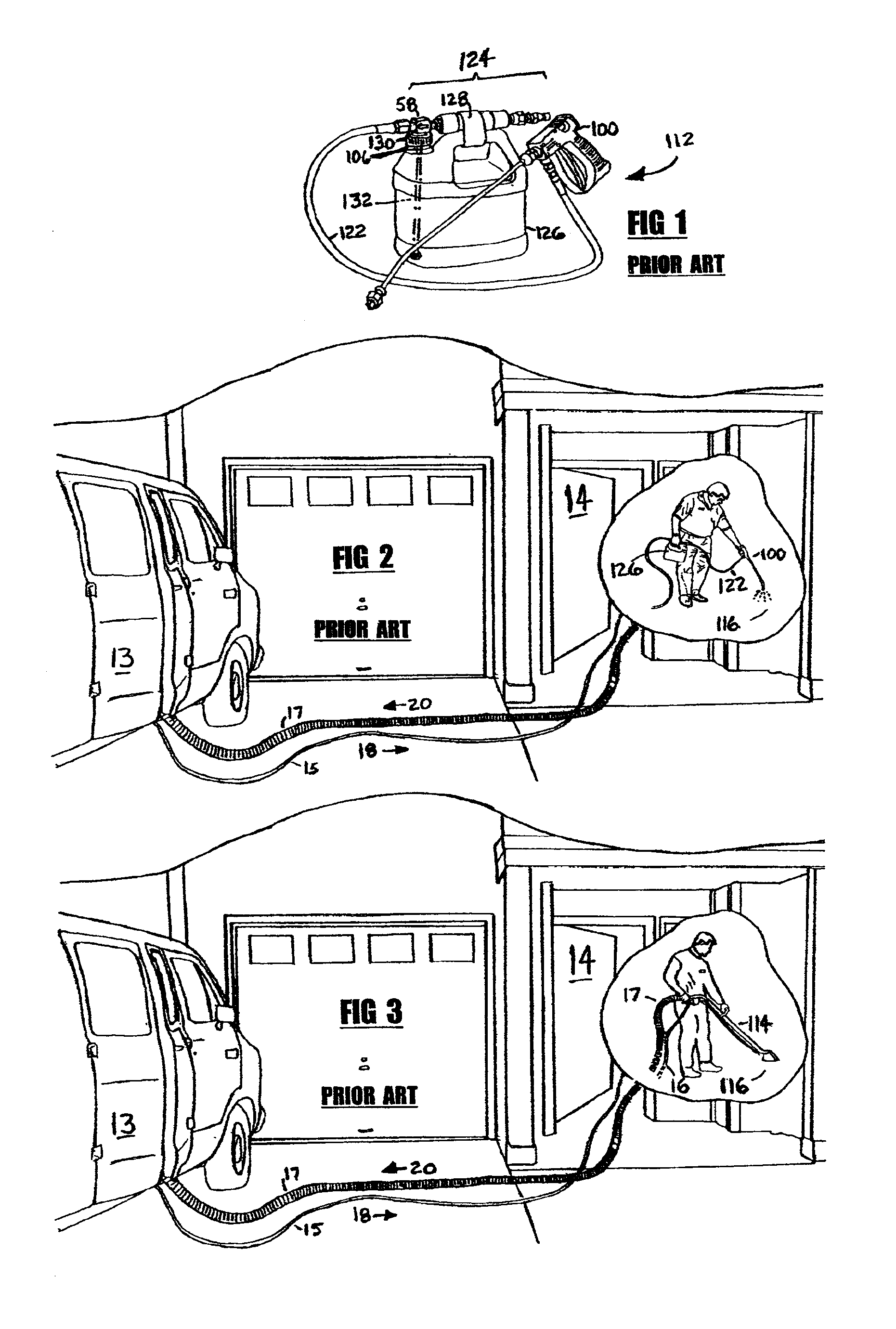Problems exist with systems that meter from the
Machine.
Storing and transporting these 5 gallon jugs consumes the work vehicle's limited storage space and fuel; but the
biggest problem with systems that meter from the
Machine is the amount of time and energy expended by the operator or (“user”) making repeated trips back and forth to the Machine as the job progresses switching or refilling the 5 gallon jugs, and / or to monitoring the
metering pump flow rate settings as needed during the job.
Further, it takes several minutes to flush the length of solution hose extending from the Machine to the cleaning site each time the switch is made (typically 100 feet or more).
The expense of such sophisticated
electronics might also be prohibitive.
Cleaners often revert to portable spraying devices to avoid this flushing problem; but available portable equipment introduces another set of problems.
Obviously, pump-up sprayers require endless manual pumping and electric sprayers require
electricity and electrical cords or batteries.
Refilling of these sprayers requires trips to the work vehicle for chemicals and manual mixing of RTU solutions thus there is potential for
dilution error.
Both types of sprayers require that RTU solution be carried throughout the cleaning site during application, which can cause fatigue.
Yet, this tubing is not known to withstand the high temperatures (>180. degree. F.) required for HWE.
Also, RTU solution in pump up and electric sprayers loses temperature as the job progresses.
The complexity of design and lack of portability of U.S. Pat. No. 5,020,917 to Homan et al.
And none of these inventions provide a way of communicating with the Machine for generating both the hot water and powerful suction necessary for achieving HWE.
Unfortunately, the prior art hand-held injection
sprayer introduces its own problems, including the fact that it is hard to use.
Carrying the hand-held injection
sprayer can be tiring.
Manipulating the length of solution supply hose 15 attached to
injector assembly is difficult as any measure of hose movement is hindered by the weight and bulk of liquid-filled jug.
Numerous jugs can be filled ahead of time, but since it is unsafe to leave a group of jugs strewn about the cleaning site 14, the user must make repeated trips to the work vehicle to retrieve and switch among jugs.
Having to stop and switch or refill jugs is tedious,
time consuming, and ruins user concentration.
Liquid concentrates are difficult to pour through the small cap opening of the jug (approximately 1½″
diameter).
Powdered concentrates are especially difficult to transfer into the jugs' small opening and even though powders are less bulky and more cost effective than their liquid equivalents, the difficulty in refilling the jug with
powder actually discourages its use.
The small cap also hinders
dissolution of both powders and liquids.
Another problem with the hand-held injection
sprayer has to do with changing the
dilution setting.
Salt Lake City, Utah, 84123) which allows the user to control the
dilution ratio more directly by simply turning a handy knob protruding from the side of the venturi
injector 58, still, there is chance for error as the user must monitor and readjust this knob each time chemical is switched during the job and any mistake will adversely affect the cleaning result.
Because it is hard to switch, refill, and adjust the
dilution ratio of the prior art hand-held injection sprayer, the user may
resist refilling it at the beginning of each job or may need more than one full jugs' worth of concentrate to finish a job; in either case, the user has to stop and refill during the job.
Injectors dedicated to individual chemicals tend to clog and malfunction; especially when sticky chemicals like presprays, or fabric protectants are used.
Maintenance is required to prevent these dedicated injectors from clogging, otherwise breakdowns occur and repair costs are incurred.
Dedicating injection sprayers also increases equipment costs and creates storage problems in the work vehicle.
All of the spraying devices known in the art suffer from a number of disadvantages:(i) They all have problems managing, transporting and dispensing a suite of chemicals.
Several 5 gal containers could be premixed to make up a days' worth of chemical (typically enough to clean 1,000 sf), but this is impractical due to space consumed and the extra fuel needed to transport them from job to job.
Flush times can be prohibitively long.
Pump up and electric sprayers can manage one or two chemicals in limited amounts (typically 1-4 gallons of RTU solution) but the
chemical waste and labor associated with emptying and replacing chemicals mid-job prohibits the use of either of these devices as a multi-chemical dispensing device.
Hand-held injection sprayer can dispense large quantities of a single chemical but the tedium of managing and transporting multiple jugs renders this device impractical as a multi-chemical dispensing device.(ii) They all present safety problems.
Chemicals metered from the Machine are often not identifiable as they enter the cleaning site.
Multiple containers accumulate throughout cleaning site creating multiple potential safety hazards.(iii) They all require trips back to work vehicle during the job.
The user spends more and more time retrieving chemicals as the total distance from Machine to cleaning site increases.(iv) They all have problems associated with the process of switching chemicals.
Chemicals and sprayers end up being strewn about the cleaning site or are kept at the work vehicle necessitating trips, which wastes time and energy.
Switching chemicals during the job using known spraying devices is so
time consuming, that it discourages users from doing so.
Some cleaners abandon proper cleaning procedures altogether, skipping the trips and simply meter large amounts of detergent through the wand.
The cleaning result is visually less than desired.
Customers are suspicious of the process; wondering how is it possible to do both a wash and a rinse in the same step.
Pump up and electric sprayers require manual measuring and mixing of chemicals with water thus there is potential for incorrect dilutions.
The new style has a handy adjusting knob built into the venturi injector itself; but if set incorrectly, over or under application will occur which may adversely effect cleaning results.(vi) They all have problems associated with refilling their chemical supply containers, especially mid-job.
While metering from the Machine, 5 gallon jugs can empty or the
metering pump can clog or malfunction with no indication to the user.
Refilling pump up sprayers requires bleeding off of hard-earned pressure and electric sprayers often need re-priming after refilling.
Regarding prior art hand-held injection sprayers, many cleaners would rather purchase a second one and keep it ready at the work vehicle rather than go through the arduous task of refilling the jug mid-job.(vii) They are all tiring.
On jobs with a lot of furniture to be moved, trip times and flush times could easily take longer than the actual time spent cleaning.
Pump up and electric sprayers wear the user down with endless manual pumping or electric cords.
Having to carry volumes of RTU solution throughout the cleaning site is also exhausting.
The prior art hand-held injector jug can get heavy and hinder solution hose control.
The device is especially awkward when trying to maneuver in tight places, behind
doors, and under draperies.(viii) They all have storage related problems.
All the spraying devices known in the art take up excessive amounts of space in the work vehicle or trailer.
Yet, many cleaners necessarily carry multiple pump up, electric, and / or hand-held injection sprayers.
 Login to View More
Login to View More  Login to View More
Login to View More 


